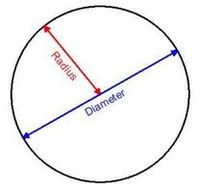Difference between revisions of "Radius and diameter of a circle"
Jump to navigation
Jump to search
(Created page with "===Name of the activity=== Brief blurb describing what the activity. If this has been borrowed from some external web site (for example, a non OER or OER site which had this...") |
|||
| Line 1: | Line 1: | ||
| − | = | + | [[File:rad_dia.jpg|200px|right|link=http://karnatakaeducation.org.in/KOER/en/index.php/File:Rad_dia.jpg]]Marking radius and diameter |
| − | |||
=== Objectives === | === Objectives === | ||
| − | + | #Radius is a straight line joining centre of a circle to any point on the circumference. | |
| − | + | #Ability to learn the use of compass. | |
| − | + | #Skill of drawing the circle accurately. | |
| − | |||
| − | |||
| − | |||
| − | |||
| − | |||
===Estimated Time=== | ===Estimated Time=== | ||
| + | 20 minutes | ||
=== Prerequisites/Instructions, prior preparations, if any === | === Prerequisites/Instructions, prior preparations, if any === | ||
===Materials/ Resources needed=== | ===Materials/ Resources needed=== | ||
| + | Different coloured papers, compass, scale, pencil and scissors. | ||
| + | |||
===Process (How to do the activity)=== | ===Process (How to do the activity)=== | ||
| − | |||
| − | |||
| − | |||
| − | |||
| − | |||
| − | |||
| − | |||
| − | + | Instructions to the teacher: | |
| + | #The teacher distributes the paper to the students. | ||
| + | #Shows them how to use compass and draw a circle. | ||
| + | #Ask every student to make 2 equal parts by folding. | ||
| + | #What happens if it is folded again to get equal parts? | ||
| + | #Ask the students to identify the folded lines/marks | ||
| + | Instructions to the student: | ||
| + | #Draw a circle of given radius. | ||
| + | #Cut out the circle. | ||
| + | #Fold the circle into two equal halves. | ||
| + | #Again fold into further equal halves. | ||
| + | #Observe and mark the folded line. | ||
| + | #Identity the diameter and radius. | ||
| + | *Evaluation | ||
| + | #Was the student successful in marking radius and diameter? | ||
| + | #Was the student successful in folding and marking? | ||
| + | #Was the student able to relate radius and diameter. | ||
| + | *Question Corner | ||
| + | #How many such radii and diameters can be drawn to a given circle? | ||
Revision as of 05:53, 7 May 2019
Marking radius and diameter
Objectives
- Radius is a straight line joining centre of a circle to any point on the circumference.
- Ability to learn the use of compass.
- Skill of drawing the circle accurately.
Estimated Time
20 minutes
Prerequisites/Instructions, prior preparations, if any
Materials/ Resources needed
Different coloured papers, compass, scale, pencil and scissors.
Process (How to do the activity)
Instructions to the teacher:
- The teacher distributes the paper to the students.
- Shows them how to use compass and draw a circle.
- Ask every student to make 2 equal parts by folding.
- What happens if it is folded again to get equal parts?
- Ask the students to identify the folded lines/marks
Instructions to the student:
- Draw a circle of given radius.
- Cut out the circle.
- Fold the circle into two equal halves.
- Again fold into further equal halves.
- Observe and mark the folded line.
- Identity the diameter and radius.
- Evaluation
- Was the student successful in marking radius and diameter?
- Was the student successful in folding and marking?
- Was the student able to relate radius and diameter.
- Question Corner
- How many such radii and diameters can be drawn to a given circle?
